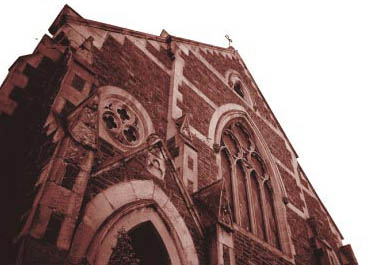| Our Environment: Issue 26 Autumn 2001 |

The prominent stone church at the corner of Brougham and Colombo Streets was built as the Wesleyan Methodist Church for the Sydenham community in 1877-8.
It was designed by Crouch and Wilson, architects from Melbourne, who had earlier designed the Durham Street Methodist Church. Local architect T S Lambert was appointed the ‘superintending architect’ and due to funding problems was forced to change some of the original design. Two large vestries with organ chamber and spire above were left out of the building contract, which explains the unfinished plastered west wall with protruding keystones.
The plan follows the Methodist ‘preaching hall’ theme. Its fašade with its simple, yet strong geometric forms and lancet windows is described as Early English Gothic.
Following construction of the building, the influence of the Methodist Church in the community grew. In the late 1880s Rev. L M Isitt attracted young people into church activities by establishing tennis and cricket clubs and building a gymnasium at the rear of the church. Through the minister and his church, Sydenham became one of the centres in the fight for prohibition. Other prominent figures associated with the building were lay preachers, Walter Bascand, a founder of an early prominent printing firm, and Rupert Pearce, manager of Aulsebrooks.
Landmark significance
The church has strong local landmark significance and relates to the development of early Sydenham, which was considered a ‘model’ borough in its founding days. It stands opposite the former Sydenham Post Office and together they form a visual gateway at the southern entrance of the commercial area of Sydenham. It is interesting that the Public Works Department opted to depart from the standard timber or brick suburban post office and faced the Sydenham building in stone to ensure it complemented the church opposite.
The church also relates to Sydenham Park, formerly the Agricultural and Pastoral Association’s showgrounds, and the King Edward drinking fountain on the park corner. This area was once the cultural and administrative heart of Sydenham. The former Sydenham Borough Council Buildings and Fire Station, both now demolished, were the last reminder of this group of buildings to the south of Brougham Street. Their demolition increases the importance of the church, which is listed in both the City Plan and Transitional District Scheme as a Group 2 protected building. It is registered by the New Zealand Historic Places Trust Pouhere Taonga, as a Category II Historic Place.
Changing patterns
Over time the size of the congregation dwindled, reflecting the changing residential patterns in Sydenham. The Methodist Church closed its doors in 1971 and the property was leased to the Seventh Day Adventist Church. Ownership of the church passed to the Samoan Congregational Church, which used the building until the mid- 1990s. An application to demolish the church in November 1997 received 86 submissions in opposition, including one with a public petition of 712 signatures.
The present owner purchased the property in September 1999 and has made efforts to liaise with the City Council, NZHPT and local branch of the NZ Institute of Architects. Much of the discussion had been centred on the potential reuse of the building rather than the upkeep and conservation of the physical fabric of the building.
The Council funded a structural report for an apartment proposal developed by institute members. This involved inserting five apartments divided by structural shear walls and new floor diaphragms inside the church structure. Later, the applicant received resource consent for the construction of four ‘start- up’ business/apartment buildings on the vacant land to the west of the church. These required consent partly because they were on the site of a protected building. Consent was granted but on the understanding that the church remained.
While other uses surfaced, along with a potential purchaser, the costs involved in the viable retention of the building have been seen as an impediment, resulting in the owner’s decision to make an application for demolition at the end of November 2000. This was to be publicly notified but the owner formally withdrew this application, awaiting Council resolution on the building’s future.
There has been considerable community interest from local residents and business people regarding the future of the church. A trust has been formed to act as a vehicle for sourcing funding and managing what looks set to become a community facility. The church may once again serve the people surrounding it.
William Fulton
| Our Environment Index |